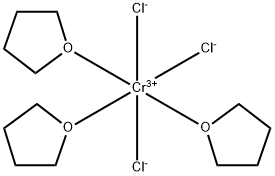Tetrahydrofurfuryl chloride
Synonym(s):2-(Chloromethyl)tetrahydrofuran
- CAS NO.:3003-84-7
- Empirical Formula: C5H9ClO
- Molecular Weight: 120.58
- MDL number: MFCD00005370
- EINECS: 221-102-3
- SAFETY DATA SHEET (SDS)
- Update Date: 2025-09-25 17:15:13

What is Tetrahydrofurfuryl chloride?
Chemical properties
Colorless to light yellow liqui
The Uses of Tetrahydrofurfuryl chloride
Tetrahydrofurfuryl chloride is an important raw material and intermediate used in organic synthesis, pharmaceuticals agrochemicals and dyestuff fields.
Synthesis Reference(s)
Organic Syntheses, Coll. Vol. 3, p. 698, 1955
Tetrahedron, 28, p. 675, 1972 DOI: 10.1016/0040-4020(72)84031-6
Properties of Tetrahydrofurfuryl chloride
| Boiling point: | 150-151 °C(lit.) |
| Density | 1.11 g/mL at 25 °C(lit.) |
| refractive index | n |
| Flash point: | 47 °C |
| storage temp. | 2-8°C |
| solubility | Not miscible or difficult to mix. |
| form | clear liquid |
| color | Colorless to Light yellow |
| Sensitive | Moisture Sensitive |
| BRN | 102716 |
| CAS DataBase Reference | 3003-84-7(CAS DataBase Reference) |
| NIST Chemistry Reference | Tetrahydrofurfuryl chloride(3003-84-7) |
| EPA Substance Registry System | Furan, 2-(chloromethyl)tetrahydro- (3003-84-7) |
Safety information for Tetrahydrofurfuryl chloride
| Signal word | Warning |
| Pictogram(s) |
 Flame Flammables GHS02  Exclamation Mark Irritant GHS07 |
| GHS Hazard Statements |
H226:Flammable liquids H315:Skin corrosion/irritation H319:Serious eye damage/eye irritation H335:Specific target organ toxicity, single exposure;Respiratory tract irritation |
| Precautionary Statement Codes |
P210:Keep away from heat/sparks/open flames/hot surfaces. — No smoking. P233:Keep container tightly closed. P240:Ground/bond container and receiving equipment. P261:Avoid breathing dust/fume/gas/mist/vapours/spray. P264:Wash hands thoroughly after handling. P264:Wash skin thouroughly after handling. P280:Wear protective gloves/protective clothing/eye protection/face protection. P303+P361+P353:IF ON SKIN (or hair): Remove/Take off Immediately all contaminated clothing. Rinse SKIN with water/shower. P305+P351+P338:IF IN EYES: Rinse cautiously with water for several minutes. Remove contact lenses, if present and easy to do. Continuerinsing. P405:Store locked up. P403+P235:Store in a well-ventilated place. Keep cool. P501:Dispose of contents/container to..… |
Computed Descriptors for Tetrahydrofurfuryl chloride
Tetrahydrofurfuryl chloride manufacturer
SRI HAAS LIFE SCIENCES PVT LTD
1Y
Phone:+91-9704226580
Whatsapp: +91-9704226580
product: 3003-84-7 Tetrahydrofurfuryl Chloride
New Products
4,4-Difluoropiperidine hydrochloride tert-butyl 9-methoxy-3-azaspiro[5.5]undecane-3-carboxylate Indole Methyl Resin N-Isopropylurea N,N-Dicyclohexylcarbodiimide(DCC) MELDRUMS ACID 5-METHYLISOXAZOLE-4-CARBOXYLIC ACID Magnessium Bis glycinate Zinc ascorbate 1-bromo-2-butyne 2-acetamidophenol 9(10H)-anthracenone Erythrosin B, 4-Piperidinopiperidine 2-((4-morpholinophenylamino) (methylthio) methylene) malononitrile 2,4-dihydroxybenzaldehyde 3-(4-morpholinophenylamino)-5-amino-1H-pyrazole-4-carbonitrile Methyl 2-methylquinoline-6-carboxylate 2,6-dichloro-4-nitropyridine 4-Bromo-2-chlorobenzonitrile 2-(benzylamino)acetic acid hydrochloride 4-(tert-Butoxycarbonylamino)but- 2-ynoic acid 3,4-dihydro-2H-benzo[b][1,4]dioxepine 1-Phenyl-1-cycloprppanecarboxylicacidRelated products of tetrahydrofuran


![tetrahydrofuro[2,3-b]furan-2(3H)-one](https://img.chemicalbook.in/CAS/20200331/GIF/104223-37-2.gif)




![tetrahydrofuro[2,3-b]furan-3(2H)-one](https://img.chemicalbook.in/CAS/20180713/GIF/445389-44-6.gif)
You may like
-
 3003-84-7 Tetrahydrofuryl chloride 98%View Details
3003-84-7 Tetrahydrofuryl chloride 98%View Details
3003-84-7 -
 3003-87-7 99%View Details
3003-87-7 99%View Details
3003-87-7 -
 Tetrahydrofurfuryl chloride 95% CAS 3003-84-7View Details
Tetrahydrofurfuryl chloride 95% CAS 3003-84-7View Details
3003-84-7 -
 Tetrahydrofurfuryl Chloride CAS 3003-84-7View Details
Tetrahydrofurfuryl Chloride CAS 3003-84-7View Details
3003-84-7 -
 3003-84-7 Tetrahydrofurfuryl ChlorideView Details
3003-84-7 Tetrahydrofurfuryl ChlorideView Details
3003-84-7 -
 20677-73-0 (2,2-diethoxyethyl)methylamine 98%View Details
20677-73-0 (2,2-diethoxyethyl)methylamine 98%View Details
20677-73-0 -
 3-(4-(hydroxyamino)-1-oxoisoindolin-2-yl)piperidine-2,6-dione 98%View Details
3-(4-(hydroxyamino)-1-oxoisoindolin-2-yl)piperidine-2,6-dione 98%View Details -
 57381-49-4 2-bromo-4-chlorobenzonitrile 98%View Details
57381-49-4 2-bromo-4-chlorobenzonitrile 98%View Details
57381-49-4
Statement: All products displayed on this website are only used for non medical purposes such as industrial applications or scientific research, and cannot be used for clinical diagnosis or treatment of humans or animals. They are not medicinal or edible.
